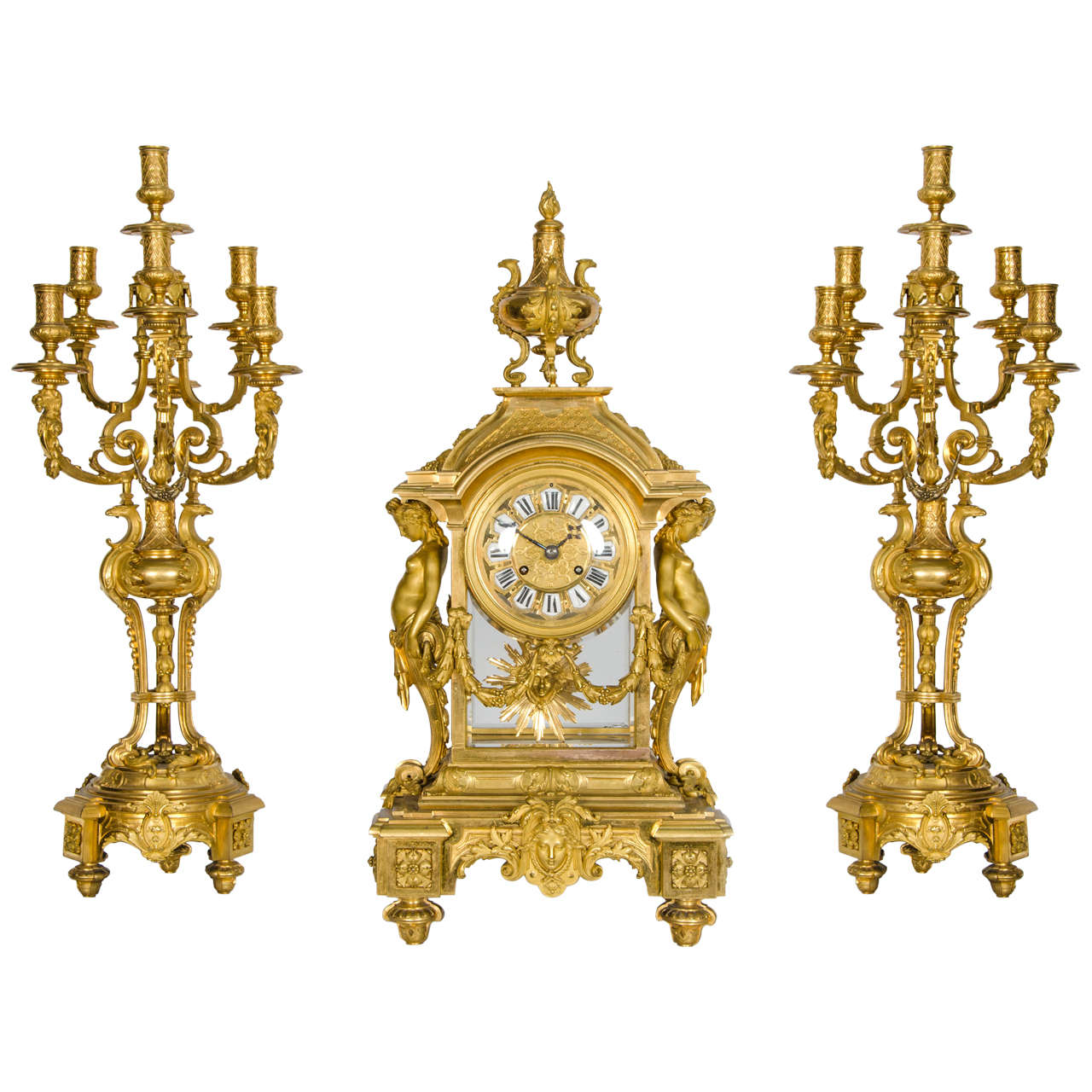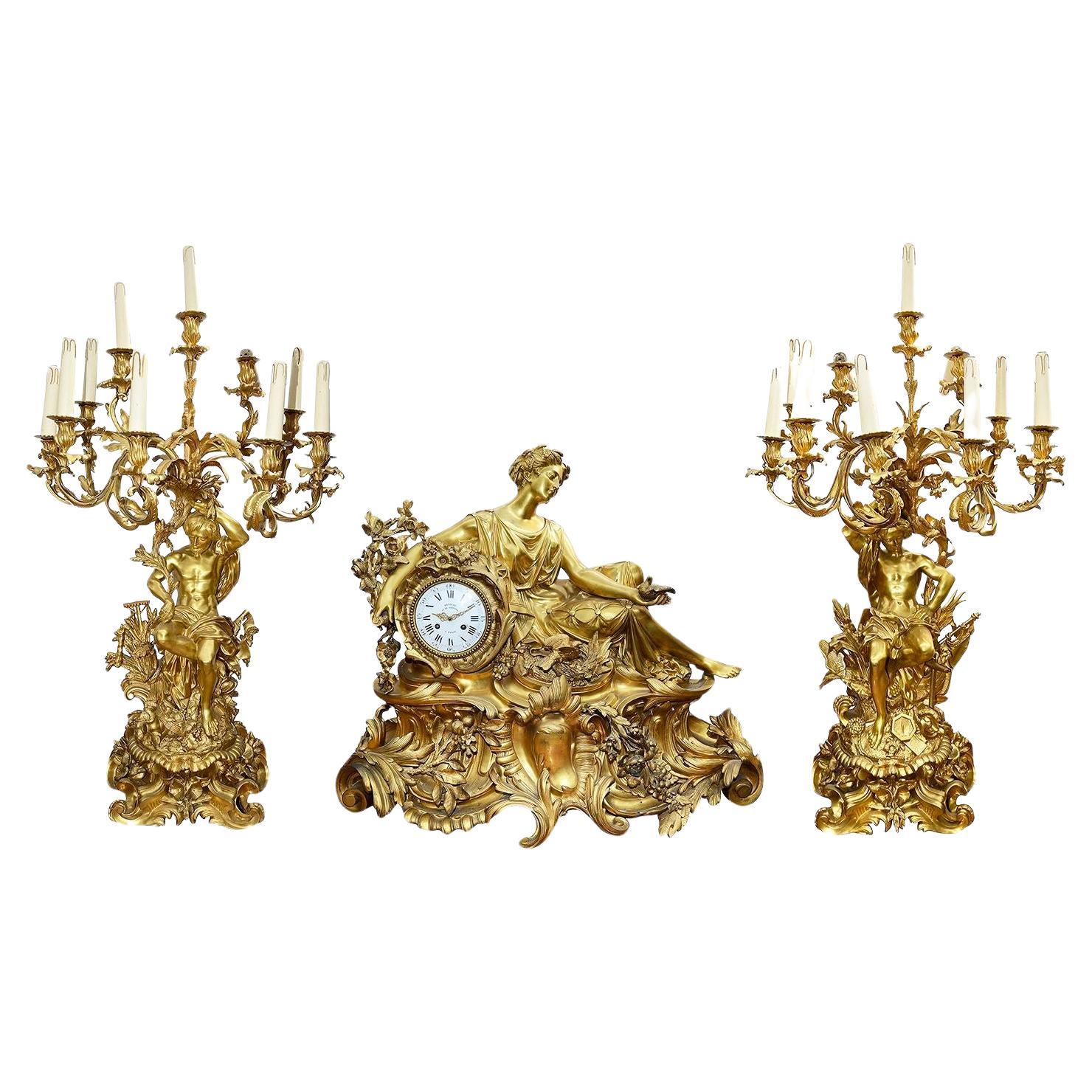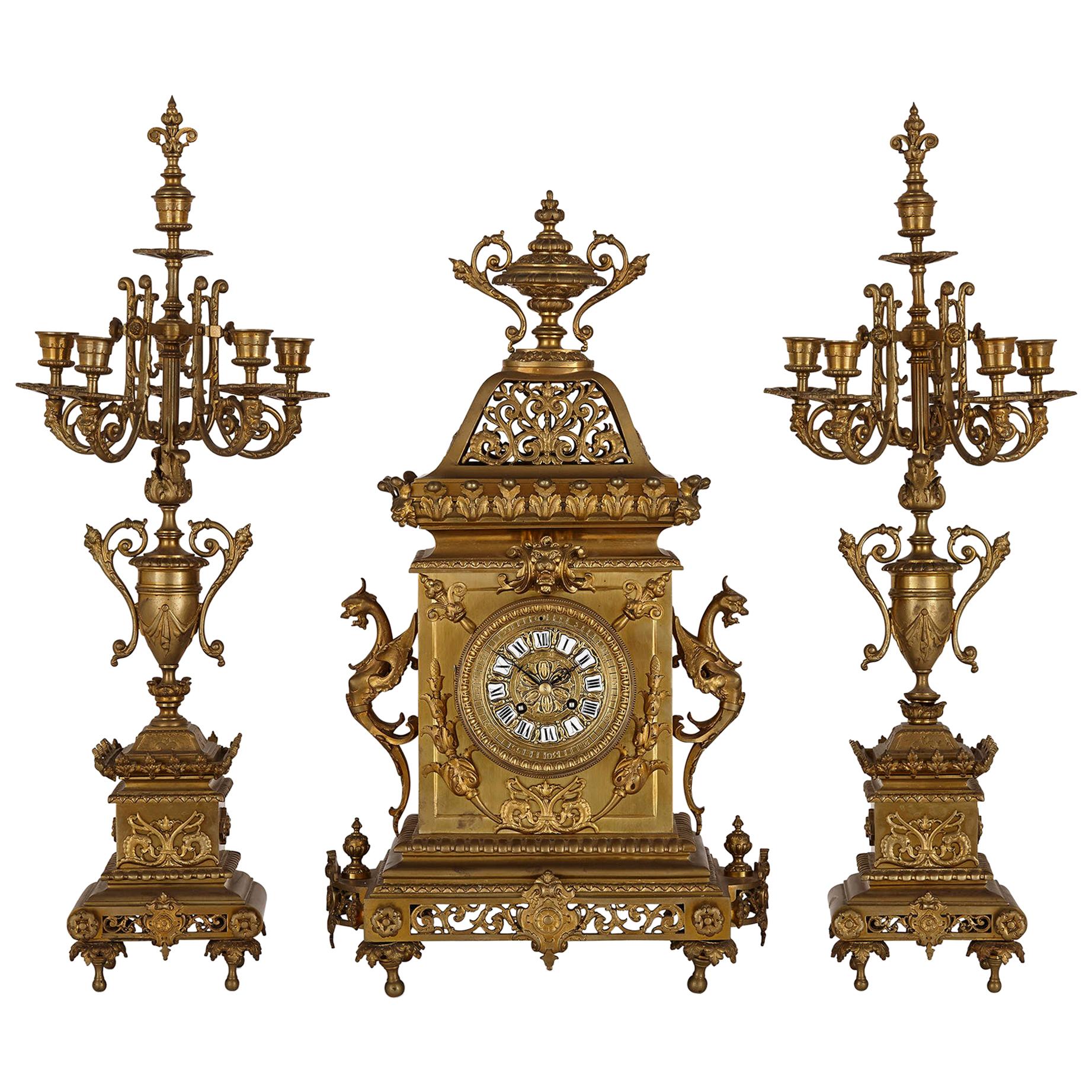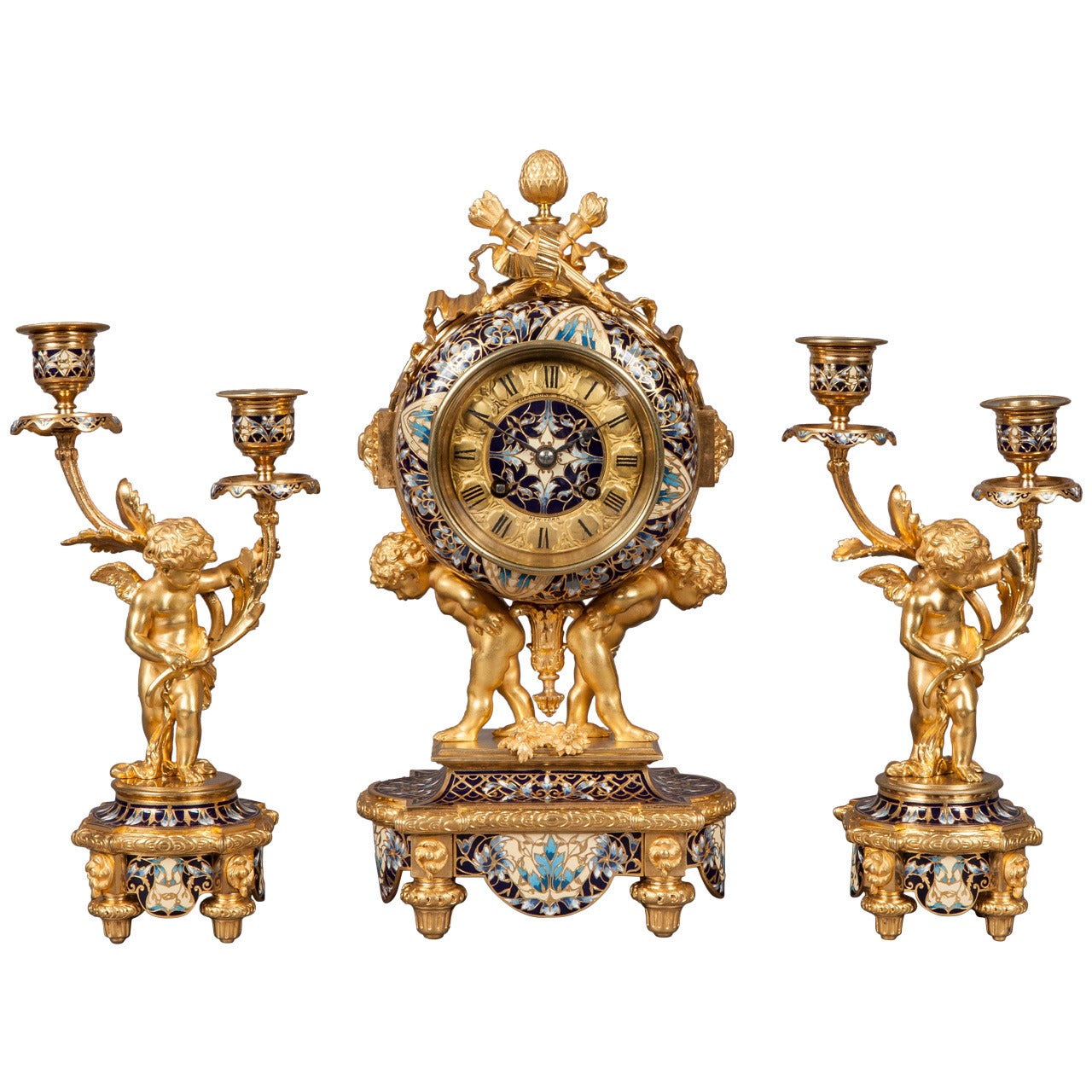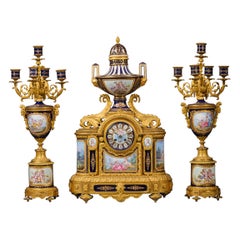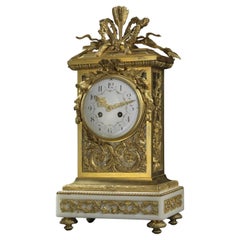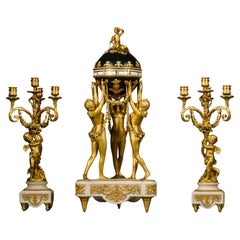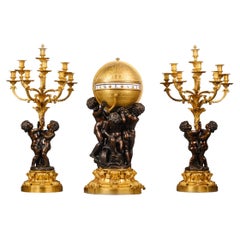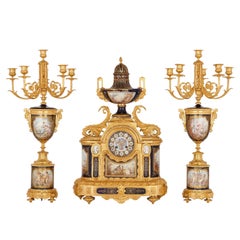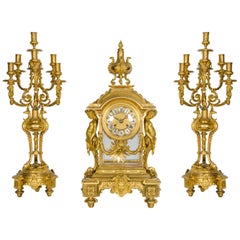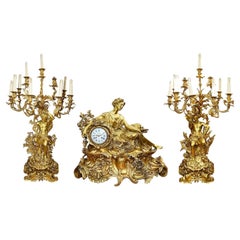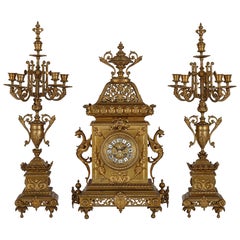Items Similar to A Monumental Renaissance Revival Clock Garniture, Attributed to Feuchère
Want more images or videos?
Request additional images or videos from the seller
1 of 14
A Monumental Renaissance Revival Clock Garniture, Attributed to Feuchère
$247,957.02
£185,000
€214,045.42
CA$347,100.89
A$382,477.42
CHF 198,384.71
MX$4,549,054.12
NOK 2,509,509.73
SEK 2,350,878.48
DKK 1,598,597.72
About the Item
A Large and Important Louis Philippe Period Gilt-Bronze Three-Piece Clock Garniture.
Attributed to the Feuchère family. The clock movement by Hémon.
In the Renaissance revival style. Comprising a clock and a pair of nine-light candelabra. The clock case of architectural out-shape with cherubic term figures supporting a rectangular pediment centred by an urn. The sides of the clock tower cast in relief with strapwork and foliage. The dial inset with enamel Roman numeral chapters. The twin-barrel clock movement with tic-tac escapement, silk suspension and countwheel strike to bell. Pendulum and winding key.
The candelabra as twin-handled vases supporting tiered branches with candle nozzles. Modelled en suite with naturalistic scrolls and foliage. Surmounted by finials modelled as an eagle toying with a serpent. The scrolled handles flanked by cherubic figures and serpents. The bodies fronted by bacchic masks and supported on socles bearing angels.
France, Circa 1835.
The clock movement signed ‘HEMON A PARIS’. The clockmaker Claude Hémon was established at rue de St. Martin circa 1810-1820.
Dimensions, the clock:
Height : 106 cm 42 inches
Width : 58 cm 23 inches
Depth : 38 cm 15 inches
Weight : 72 kg
Dimensions, the candelabra:
Height : 104 cm 41 inches
Width : 36 cm 14 inches
Depth : 36 cm 14 inches
Weight : 28 kg (each)
This magnificent clock garniture of palatial size is designed in the Renaissance revival style and dates to the Louis Philippe period. Executed in sculptural gilt-bronze with leaves, scrolls, masks and exotic birds, the naturalistic ornament represents an elaborate system of allegories and mythological iconography which recall the influence of Italian Mannerist art in France.
The distinctive design reflects a new style which replaced the neoclassism of the French Empire period. With the fall of Napoleon Bonaparte, artists and designers sought a new decorative vocabulary with which to aggrandise the Bourbon restoration. With the French revolution and Louis XVI’s execution still within living memory, it seemed too soon for a revival of the style of the Grand Siècle. Instead they looked further back to the time of François I, whose patronage of Italian artists had brought the Renaissance to France. The idea of a renaissance revival appealed to the new Bourbon monarchs and their patronage ignited great creativity in the arts.
The reigns of Louis XVIII and Charles X, who were brothers of the late King, Louis XVI, and later of Louis Philippe I, nicknamed the Citizen King, coincided with the enlightenment and the dawn of the industrial age. Great technical progress was made in metallurgy and casting which raised the art of bronze making to new heights in the hands of great masters such as Pierre-Philippe Thomire (1751-1843) and Pierre- Jean-François Denière (1774-1866).
The renaissance provided a rich and varied source book in architecture, furniture and other decorative arts for designers such as Claude Aimé Chenavard (1798-1838) whose Album de l’ornemaniste (1835) became a reference work. Léon Feuchère (1804-1857) also produced drawings of interiors, silver, bronzes and furniture and was a scion of the prominent family of bronze castors established by his grandfather Pierre-François Feuchère (1737-1823) who had worked as a gilder for the bronze caster Pierre Gouthière before setting up a bronze foundry that would become one of the largest in Paris under the management of his son Lucien-François (d. 1841) and grand-son Armand (1797-1866). A number of drawings by Léon Feuchère have recently been discovered by the Rijksmuseum and probably belonged to the collection of Louis-Philippe-Albert, duc d’Orléans, comte de Paris (1838-1894). Louis-Philippe-Albert was the grandson of the French king, Louis-Philippe I (1773-1850), who granted him the title of comte de Paris, and the son of Ferdinand-Philippe, duc d’Orléans (1810-1842). Ferdinand-Philippe was an important collector and sponsored many young artists to create metalwork objets d’art, notably a celebrated surtout de table made by Claude-Aimé Chenavard and Jean-Jacques Feuchère (1807-1852), a cousin of Armand and Léon. Principally remembered as a sculptor, Jean-Jacques Feuchère trained in the family foundry and designed small objects, cigar boxes, chandeliers, clocks and vases of various types. Armand Feuchère showed a clock and two candelabras at the 1844 Exposition des produits de l'industrie française in 1844.
Comparative Literature:
Un âge d'or des arts décoratifs : 1814-1848. Exhibition Cataloague. Paris. 1991 (Feuchère, p. 523).
Esther Van Der Hoorn,'Feuchère Designs in the Rijksmuseum', The Rijksmuseum Bulletin, 2018, Amsterdam, pp. 24-43.
- Dimensions:Height: 41.74 in (106 cm)Width: 22.84 in (58 cm)Depth: 14.97 in (38 cm)
- Style:Renaissance Revival (Of the Period)
- Materials and Techniques:
- Place of Origin:
- Period:
- Date of Manufacture:Circa 1835
- Condition:Wear consistent with age and use. The movement has been professionally cleaned and overhauled.
- Seller Location:Brighton, GB
- Reference Number:Seller: B775061stDibs: LU1028044683302
About the Seller
5.0
Recognized Seller
These prestigious sellers are industry leaders and represent the highest echelon for item quality and design.
Established in 1964
1stDibs seller since 2014
59 sales on 1stDibs
Typical response time: 1 hour
Associations
The British Antique Dealers' AssociationLAPADA - The Association of Arts & Antiques Dealers
- ShippingRetrieving quote...Shipping from: Brighton, United Kingdom
- Return Policy
More From This Seller
View AllNapoléon III Sèvres Style Clock Garniture
Located in Brighton, West Sussex
A fine Napoléon III gilt-bronze and sèvres style cobalt blue ground 'Jewelled' Porcelain Three-Piece Clock Garniture
Comprising a mantel clock and a pair of five-light vase candel...
Category
Antique 19th Century French Napoleon III Mantel Clocks
Materials
Ormolu
A Louis XVI Style Mantel Fine Gilt-Bronze Clock by François Linke
By François Linke
Located in Brighton, West Sussex
A Very Fine Gilt-Bronze Clock With A White Marble Base by François Linke.
The case signed 'Linke'.
This rare example of a clock by François Linke has a twin train eight-day mov...
Category
Antique 19th Century French Louis XVI Mantel Clocks
Materials
Marble, Enamel, Ormolu
A Louis XVI Style Gilt and Patinated Bronze and Marble Clock Garniture
By Jollet & Cie
Located in Brighton, West Sussex
A Louis XVI Style Gilt and Patinated Bronze and Marble Clock Garniture, Comprising a 'Pendule à Cercles Tournants' Modelled with the Three Graces and a Pair of Cherub Four-Light Cand...
Category
Antique 19th Century French Louis XVI Mantel Clocks
Materials
Marble, Ormolu
Cercles Tournants Clock Garniture by Deniere, Paris
By Jean-François Denière
Located in Brighton, West Sussex
A Rare and Exceptional Gilt and Patinated Bronze Monumental Cercles Tournants Clock Garniture, by Deniere, Paris.
The backplate signed 'DENIERE...
Category
Antique 19th Century French Louis XVI Mantel Clocks
Materials
Bronze
Elaborate Gilt Bronze and Sèvres-style Porcelain Mantel Clock, circa 1870
Located in Brighton, West Sussex
A fine and elaborate gilt bronze and Sèvres-style porcelain mantel clock.
French, circa 1870.
A fine and elaborate gilt bronze and Sèvres-style porcelain mantel clock with a fo...
Category
Antique Late 19th Century French Louis XVI Mantel Clocks
Materials
Bronze
Important Napoléon III Gilt-Bronze and Porcelain Clock Garniture, circa 1870
Located in Brighton, West Sussex
An important Napoléon III gilt bronze and turquoise porcelain clock garniture.
French, circa 1870.
This very fine clock garniture comprises of a clock and a pair of vase form candelabra.
The finely cast and chiselled gilt bronze case has a jewelled turquoise porcelain face with Roman Numerals above a plaque depicting children in a wooded landscape, flanked by expressive male and female cherub figures, cast in the round, beneath a scrolled pediment with torches en flambeau and surmounted by a turquoise vase and cover.
The pair of candelabra en-suite are in the form of turquoise porcelain vases...
Category
Antique Late 19th Century French Napoleon III Mantel Clocks
Materials
Bronze
You May Also Like
Fine Quality 19th Century Sevres Style Clock Garniture
By Manufacture Nationale de Sèvres
Located in Brighton, Sussex
A fine quality 19th century French Sevres style porcelain and gilded ormolu clock garniture. The pair of five branch gilded ormolu candelabra each having Sevres style porcelain urns and pedestals with classical romantic scenes painted on them. The clock having an impressive lidded porcelain urn above with gilded handles either side, scrolling foliate ormolu mounts above the porcelain faced eight day duration clock that chimes...
Category
Antique 19th Century French Louis XVI Mantel Clocks
Materials
Ormolu
$30,022 Sale Price
20% Off
Imposing 19th Century French Ormolu Clock Garniture 29"(73cm) high
Located in Brighton, Sussex
A large and impressive, very good quality French gilded ormolu clock garniture. The clock supported by a pair of Caryatids, decorated with swags and classical motifs, four bevelled g...
Category
Antique 1860s French Mantel Clocks
Materials
Ormolu
Important 19th Century French clock garniture by Deniere.
By Maison Deniere
Located in Brighton, Sussex
A wonderfully impressive 19th Century French gilded ormolu clock garniture, by Deniere of Paris. The clock having a classical reclining maiden holding doves among flowers and foliage...
Category
Antique Late 19th Century French Louis XVI Mantel Clocks
Materials
Ormolu
French Régence Style Gilt Bronze Clock Garniture
Located in London, GB
French Régence style gilt bronze clock garniture
French, late 19th century
Clock: Height 60cm, width 36cm, depth 20cm
Candelabra: Height 67cm, width 25cm, depth 25cm
This wonde...
Category
Antique Late 19th Century French Mantel Clocks
Materials
Ormolu, Bronze
$7,036 Sale Price / set
30% Off
French Mantle Clock Garniture in the Louis XVI Manner
Located in London, GB
Constructed in gilt bronze and decorated with champleve´ enamel; the candelabra have toupie feet supporting the shaped circular bases, on which winged cherubs hold two armed candle a...
Category
Antique 1880s French Louis XVI Clocks
Materials
Enamel, Ormolu
19th Century French Clock Garniture
Located in Brighton, Sussex
A good quality French bronze and ormolu clock garniture, having bronze cherubs mounted either side of the clock and supporting the five branch candelabra.
Retailer; Humbert.
Category
Antique 1860s French Mantel Clocks
Materials
Bronze
$10,052 / set
More Ways To Browse
Small Clock
Tower Clock
Italian Early 19th Century Chandelier
Monumental French Bronze
Large Late 19th Century French Bronze Chandelier
Twin Handle Vases
Roman Numeral Clock
Architecture Book
Small Antique Chandeliers
Antique Tower Clock
Pierre Gouthiere
Antique Clock Box
French Clock Movement
Antique French Clock Movement
Gilt Bronze Surtout De Table
Antique Architecture Book
Bronze Eagle Signed And Numbered
Tiered Vase

